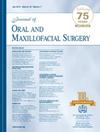The Effects of Different Bimaxillary Orthognathic Surgery Sequencing on the Temporomandibular Joint Space of Skeletal Class II Malocclusion Patients
IF 2.6
3区 医学
Q2 DENTISTRY, ORAL SURGERY & MEDICINE
引用次数: 0
Abstract
Background
Changes in the temporomandibular joint (TMJ) space are known consequences of bimaxillary surgery, and the surgery sequence may influence postoperative TMJ space or risk of relapse.
Purpose
The purpose of this study was to measure the association of bimaxillary surgery sequence and changes in the TMJ space over time in patients with skeletal Class II malocclusion.
Study Design, Setting, and Sample
A retrospective cohort study involving patients with skeletal Class II malocclusion who underwent bimaxillary orthognathic surgery was conducted at the Hospital of Stomatology, Wuhan University from 2018 to 2021. Patients without complete cone beam computed tomography were excluded.
Predictor Variable
The predictor variable was sequence of bimaxillary orthognathic surgery, grouped as mandible-first and maxilla-first.
Main Outcome Variables
The main outcome variables were radiographic linear measurements and changes in the anterior joint space, posterior joint space (PJS), and superior joint space (SJS) at 3 time points: preoperative, 1 week postoperative, and 6–12 months postoperative.
Covariates
The evaluated covariates included sex, age, mandibular advancement.
Analyses
Repeated-measures analysis of variance was used to assess changes in joint space over time and side, with surgical sequence as a between-subjects factor. Additional analyses included independent t-tests and canonical correlation. (P ≤ .05).
Results
The sample comprised 48 subjects (96 joints), with a mean age of 29.2 (8.5) years; 11 (23%) were male. At 1 week postsurgery, the Maxilla-First group showed a significantly greater radiographic increase in SJS than the Mandible-First group (mean difference: 1.3 mm; 95% CI: 0.7–2.0; P = .0005). At the same time point, all 3 joint spaces (SJS, anterior joint space, and PJS) increased significantly in both groups (P < .05). By 6–12 months postoperatively, surgery sequence showed a negative effect on TMJ space changes, as SJS and PJS significantly decreased in the maxilla-first group (mean differences: 1.9 and 1.1 mm; 95% CIs: 1.2–2.5 and 0.3–1.8; P = .0001 and .005, respectively).
Conclusions and Relevance
TMJ space changes in skeletal Class II malocclusion varied over time and were associated with the order of surgery sequence, with smaller changes observed in the mandibular-first group.
不同双颌正颌手术顺序对骨骼ⅱ类错颌患者颞下颌关节间隙的影响。
背景:颞下颌关节(TMJ)间隙的改变是已知的双颌手术的后果,手术顺序可能影响术后TMJ间隙或复发的风险。目的:本研究的目的是测量骨性II类错颌畸形患者的双颌手术顺序与颞下颌关节间隙随时间变化的关系。研究设计、背景和样本:2018 - 2021年在武汉大学口腔医院行双颌正颌手术的骨骼ⅱ类错颌患者进行回顾性队列研究。没有完整锥形束计算机断层扫描的患者被排除在外。预测变量:预测变量为双颌正颌手术顺序,分为下颌骨优先和上颌优先。主要结果变量:主要结果变量为术前、术后1周和术后6-12个月3个时间点的x线测量和关节前间隙、关节后间隙(PJS)和关节上间隙(SJS)的变化。协变量:评估的协变量包括性别、年龄、下颌前移。分析:使用重复测量方差分析来评估关节间隙随时间和侧面的变化,手术顺序作为受试者之间的因素。其他分析包括独立t检验和典型相关。(p≤0.05)。结果:样本包括48名受试者(96个关节),平均年龄29.2(8.5)岁;11例(23%)为男性。术后1周,上颌第一组SJS的x线表现明显高于下颌骨第一组(平均差异:1.3 mm;95% ci: 0.7-2.0;P = .0005)。同一时间点,两组3个关节间隙(SJS、前关节间隙、PJS)均显著升高(P < 0.05)。术后6-12个月,手术顺序对TMJ间隙变化有负面影响,上颌第一组SJS和PJS显著降低(平均差异1.9和1.1 mm;95% ci: 1.2 ~ 2.5和0.3 ~ 1.8;P = 0.0001和0.005)。结论及相关性:骨ⅱ类错颌的颞下颌关节间隙变化随时间的变化而变化,且与手术顺序有关,下颌先颌组的变化较小。
本文章由计算机程序翻译,如有差异,请以英文原文为准。
求助全文
约1分钟内获得全文
求助全文
来源期刊

Journal of Oral and Maxillofacial Surgery
医学-牙科与口腔外科
CiteScore
4.00
自引率
5.30%
发文量
0
审稿时长
41 days
期刊介绍:
This monthly journal offers comprehensive coverage of new techniques, important developments and innovative ideas in oral and maxillofacial surgery. Practice-applicable articles help develop the methods used to handle dentoalveolar surgery, facial injuries and deformities, TMJ disorders, oral cancer, jaw reconstruction, anesthesia and analgesia. The journal also includes specifics on new instruments and diagnostic equipment and modern therapeutic drugs and devices. Journal of Oral and Maxillofacial Surgery is recommended for first or priority subscription by the Dental Section of the Medical Library Association.
 求助内容:
求助内容: 应助结果提醒方式:
应助结果提醒方式:


